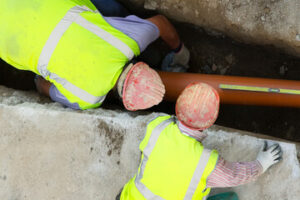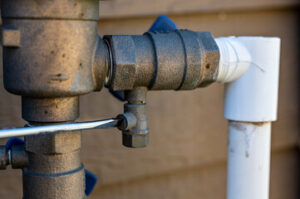Sewer Line Installation Mistakes
Plumber North Olmsted Ohio works on the water systems that distribute water and waste in residential, commercial and industrial settings. Their duties include inspecting pipes; testing pressure levels; locating leaks; and fitting new plumbing fixtures.

Wet rings on the ceiling and low water pressure are telltale signs that it’s time to call a professional. Here are some tips on what to expect from a sewer repair:
A faulty or damaged sewer line can lead to unpleasant and dangerous situations for homeowners. A plumber can fix these problems, restoring the flow of sewage and eliminating odors. Before starting a repair job, the plumber must locate the source of the problem. This is usually done using a sewer camera, which helps to locate breaks, blockages, and other issues. The plumber then digs a trench, removes the damaged pipe, and installs a new one. The cost of labor for this type of work can be expensive, but the repairs are necessary to keep the home safe and sanitary.
When a sewer line is broken or clogged, it can cause serious damage to the property and health of the residents. In some cases, the sewage can leak out of the pipes and into the surrounding soil, creating a sinkhole. To avoid costly repairs, property owners should regularly have their sewage lines inspected and maintained by a professional plumber.
Symptoms of a broken sewer line include gurgling noises from toilets and drains. The gurgling is caused by air that gets trapped in the pipes due to a blockage. Another symptom is water flooding the basement or other floors of the home. If these symptoms occur, the homeowner should call a plumber immediately.
A plumber can diagnose a broken sewer line by running a camera through the pipes. After the inspection, he or she will mark the location of the pipes on the surface with spray paint. This will help to ensure that the plumber doesn’t damage utility lines, sprinklers, or electric dog fences during the repair process. The plumber may also need to get permission from neighbors if the pipes are located on their property.
There are several different options for sewer repair, including trenchless repair. This method involves inserting a liner dipped in epoxy into the existing pipe. The liner will then be inflated, which will repair any cracks or holes and restore the integrity of the pipe. This is a great option for properties with shallow pipes that are easy to access. However, it is not suitable for older pipes with significant damage or for those that require extensive digging.
Sewer Cleaning
Sewer systems are a vital part of every building, but they’re often neglected. This is because they handle sewage, which contains dangerous bacteria and chemicals that can cause sickness in people if not properly disposed of. As a result, they need to be cleaned and maintained regularly to keep them working correctly. Regular sewer cleaning can help avoid blockages, clogged drains, and expensive repairs down the road.
One of the most common signs that a sewer line is in need of cleaning is an unpleasant odor. This can occur when waste accumulates inside the lines and begins to decompose, causing the pipes to smell. It can also be a sign of a broken or cracked pipe that needs to be repaired or replaced. In either case, a professional plumber can help.
There are several methods that plumbers use to clean sewer lines. The most common is called hydro jetting, which uses water pressure to break up and remove obstructions. This method is safe for pipes and environmentally friendly. It can be used on a wide range of debris, including tree roots, dirt, sludge, and more. Plumbers can also use a plumbing snake to clear blockages. This is a long rod that looks similar to a garden hose and is equipped with a head at the end that can break up or hook onto obstructions in the line.
If a clog is too large for hydro jetting, a plumber may need to use chemical methods to remove it. These can include acids and other government-approved solutions that will dissolve grease, stop root growth, and disinfect the line. Another option is a combination machine that uses both hydraulic cleaning and chemical methods to remove debris and clogs.
Sewer Replacement
Licensed plumbers have extensive technical training and experience in diagnosing sewer issues. Their diagnostic tools, including sewer cameras, allow them to accurately pinpoint problems and determine the best course of action. In addition, they know local codes and can help you navigate complex sewer line replacement procedures, such as obtaining permits and adhering to environmental regulations.
Plumbing companies offer a variety of sewer repair and replacement options, including non-invasive trenchless technologies. These methods are less expensive and faster than traditional excavation. Additionally, they can minimize property damage and restore landscaping and structures. Choosing the right plumber will save you money in the long run. Look for a company that clearly explains its recommendations, offers transparent pricing, doesn’t cut corners on quality, and looks out for your best interests.
If you’re experiencing signs of a failing sewer line, such as unpleasant odors or water backups, it’s important to contact a professional immediately. Neglecting a broken sewer line can lead to costly repairs and health risks, such as flooding, mold, mildew, and bacterial contamination.
In some cases, a complete pipe replacement is necessary. However, if your pipes are in good condition and have a positive slope, you may be able to save money with a trenchless sewer line replacement. This process involves inserting an epoxy-saturated tube into your existing pipes, inflating it, and curing it with hot air or steam. Once cured, the new tube creates a strong seal that can last for decades.
The cost of sewer repair and replacement can vary significantly depending on a number of factors, such as the location of the pipes, their age and material type, and the size of the pipe. A longer pipe can also cost more to replace than a shorter, shallower one. Additionally, your home’s location and the depth of the sewer lines in the ground can influence how much labor is required to reach them.
Sewer Installation
A well-executed sewer line installation is crucial for the hygiene and functionality of any property, whether it’s a residential or commercial building. However, mistakes made during the excavation and installation process can result in costly repairs, environmental hazards, and significant inconveniences. Knowing these common errors and how to avoid them can help you get the most out of your new sewer line.
The first mistake is failing to check for existing lines before digging. It’s essential to consult a professional before starting any work on your sewer system to make sure there are no existing pipes in the area. It’s also vital to ensure your plumber has a valid permit to dig, as failing to do so could result in fines and the need to redo the work.
Another common error is choosing the wrong pipe material. It’s important to choose a durable, corrosion-resistant material that can withstand the load and soil conditions of your location. It’s also a good idea to conduct regular inspections of your sewer line to ensure it’s in good condition and to catch any problems early on, such as small cracks or tree roots invasion.
It’s also critical to make sure your sewer pipe is properly sloped. The slope of your sewer pipe determines how waste will drain via gravity. A poorly sloped sewer line can lead to sewage backups and blockages. A qualified plumber will be able to determine the proper slope for your sewer line based on your home’s location and needs.
Finally, it’s essential to install a vent pipe for your sewer system. This is necessary for proper ventilation and can prevent odors from entering the house. It’s also a good idea for homeowners to regularly inspect their vent pipes for signs of clogs.
